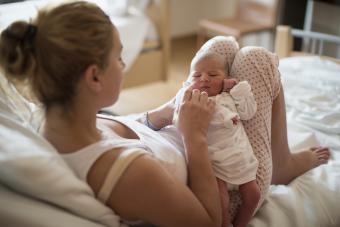
If you're a California resident who's about to become a parent, it's a good idea to get informed about the state's laws regarding maternity leave. The family leave laws in this state are some of the best in the nation. All eligible new parents in the state qualify for up to six weeks of paid bonding leave, and additional paid benefits may be available for periods of disability associated with pregnancy and childbirth. Knowing your rights and responsibilities about maternity leave in California will help make your leave, and your baby's first weeks at home, go smoothly.
California Paid Family Leave
With the addition of a Paid Family Leave (PFL) law that went into effect in 2004 as an extension of the State Disability Insurance (SDI) program, California is considered a leader in working moms' rights. California's PFL program provides partial pay for eligible new parents for up to six weeks. This is bonding leave that applies to both parents, so it is a form of paid parental leave rather than solely being maternity leave.
Qualifying for PFL
In order to qualify for PFL, you'll need to meet the following eligibility requirements:
- You must reside in California.
- You must have contributed to State Disability Insurance (SDI), an automatic deduction from most people's paychecks.
- You must be taking time off to bond with a newborn, a foster child, or an adopted child, or to care for an ill family member. You will need a doctor's note to support your claim.
- For child bonding, the leave must be taken within one year of birth, adoption or foster care placement.
Explanation of Benefits
If you qualify for PFL, you can receive up to six weeks' worth of wages at a reduced level, which equates to between 60 and 70% of your average weekly income during the base period. To compute your payment, the state reviews your pay during a twelve month base period and uses the highest quarterly earnings to determine benefits. Wages the person was paid for the previous five to 18 months are included in the base period, presuming they were subject to SDI withholding.
Eligible individuals with at least $300 worth of earnings during the base period qualify for benefits. As of 2019, the minimum weekly benefit is $50 and the maximum is $1,252. These amounts apply to claims that started on or after January 1, 2019.
- Individuals with quarterly earnings less than $928.99 will receive the minimum weekly benefit of $50.
- This with quarterly earnings between $929 and $5,385.37 will receive approximately to 70% of their weekly earnings.
- This with quarterly earnings between $5,385.38 and $27,126.66 will receive approximately 60% of their earnings per week.
- Those with quarterly earnings of $27,126.67 or more will receive the maximum weekly benefit of $1,252.
For a helpful maternity leave pay calculator, see the Weekly Benefit Amounts Chart provided by the State of California's Employment Development Department. It includes details on benefit calculations at all wage levels.
Additional PFL Considerations
There are a few other important things to consider regarding the PFL benefit:
- There is a week-long waiting period before your benefits will begin.
- Your employer may have you use up to two weeks of your vacation time or sick days before you begin receiving your PFL benefits.
- You can take your PFL benefit in bits and pieces. You don't need to take six consecutive weeks off work.
- Both parents are eligible for PFL. Parents may take their leave at the same time, or they may stagger it.
How to Claim PFL
Your employer does not pay PFL benefits. Instead, the State of California handles these payments and approves your application. If you are wondering how to apply for maternity leave in California, visit the State of California Employment Development Department website or call 1-877-238-4373 to apply for PFL.
Paid Pregnancy-Related Disability Coverage in CA
Women who live in California and experience disability related to pregnancy or childbirth may qualify for additional state disability insurance (SDI) benefits beyond the bonding leave provided for under PFL, for up to one year (as medically necessary). Qualifying for SDI payments, however, does not guarantee that your employer will be required to restore your job after a 1-year period. Eligibility and timelines for job protection fall under laws that mandate job restoration (but not compensation). They are the California Family Rights Act, the California New Parent Leave Act, and the federal Family Medical Leave Act.
Qualifying for SDI Disability Leave
In order to qualify for disability payments related to pregnancy or childbirth under California's state disability insurance (SDI) program, you'll need to meet these criteria:
- You must be a California resident.
- You must have earned income and have contributed to SDI.
- For at least eight consecutive days, you must be unable to perform the basic functions of your job due to your disability.
- You must be under a doctor's care during the first eight days of your disability.
- You must not be receiving PFL at the same time as a disability leave benefit; however, you can begin receiving PFL after you are no longer eligible for disability leave.
The timeline for SDI leave related to pregnancy disability is tied to an individual's specific circumstances. California doctors often recommend pregnancy disability leave for four weeks before a new mother's due date, as well as for several weeks after childbirth. In some cases, disability leave may be recommended required more than four weeks in advance.
Explanation of Benefits
Benefit payments are calculated in the same manner as PFL benefits, though there is not a six-week limit. SDI benefits may be paid for up to a year, based on medically-certified necessity and base period wages.
How to Claim
To file a disability insurance claim related to pregnancy in the State of California, visit the State of California Employment Development Department website. You can also call 1-800-480-3287 to speak to someone who can help you navigate this process.
California Family Rights Act
The California Family Rights Act (CFRA) can be used to take additional time off for bonding with a new child, and it also provides for additional leave specific to pregnancy disability. If a woman meets the eligibility requirements for CFRA, she can take up to 12 weeks of leave for bonding with her new child, as well as an additional four months of job protected leave associated with pregnancy disability. This means that those who qualify can take the four months of pregnancy leave along with up to twelve weeks of CFRA for bonding with the baby after birth.
Qualifying Under the CFRA
In order to qualify for CFRA, you'll need to meet these criteria:
- You must have worked for your employer for at least a year. Full or part-time employment are both eligible.
- Your company must employ at least 50 employees within a 75 mile radius.
- The parent must have logged at least 1,250 hours in the last year.
- You must be a California resident.
- Both parents qualify for this leave.
- Biological and adoptive parents qualify, including same-sex partners/spouses
Bonding Leave Under CFRA
CFRA covers 12 weeks of bonding time for the parent and child. This applies to individuals who have a baby, as well as those who adopt or foster a child. Leave must be taken within one year of the birth, adoption or beginning of foster care.
Pregnancy Disability Leave (PDL) Regulations Under CFRA
Separate from bonding time, CFRA requires covered California employers to allow pregnant women up to four months of pregnancy disability leave, if needed, in addition to bonding time.
Under CFRA, pregnancy disability may include:
- Severe morning sickness
- Prenatal care
- Physician-ordered bed rest
- Childbirth
- Recovery from childbirth
Note: These circumstances may not result in eligibility for SDI benefits; there is a difference in CFRA job protection leave and eligibility for disability insurance payments.
Explanation of Benefits
The CFRA does not provide any income replacement during your leave. Instead, it simply guarantees that your job will still be there when you return to work.
Requesting Leave
It's important that you give your employer as much notice as possible, preferably in writing, before you plan to take your leave. Check with your company's HR department to find out exactly what is expected of you.
Learn More
For more information about the CFRA and your rights under the law, download this publication from the California Department of General Services.
California New Parent Leave Act
The California New Parent Leave Act went into effect in 2018. Similar to CFRA, the significance of this law is that it extends coverage to employers who have 20 or more employees within a 75-mile radius. As with CFRA, employees become eligible for this type of leave when they have been employed by a covered employer for a year and have worked 1,250 hours or more within the 12-month period preceding their leave. The law provides for 12 weeks of job protected leave related to becoming a parent of a newborn baby, adopting a child, or becoming a foster parent.
Federal Family and Medical Leave Act
Federal laws also protect California women who take a maternity leave. The Family and Medical Leave Act (FMLA), which was passed in 1993, guarantees that women can take up to twelve weeks without pay while keeping the same health insurance. Additionally, their position will be held while gone, or else a job with equal pay, benefits, and status will be given. It applies to employers with 50 or more employees within a 75-mile radius.
- CFRA and FMLA are similar, though the California law does provide protections beyond what are included in the federal law (such as pregnancy disability protection).
- In most cases, the CFRA benefits from the State of California supersede the FMLA. To learn more about FMLA, visit the United State Department of Labor website.
Other Maternity Leave Options
California maternity leave options do not always end at the state and federally mandated laws. Companies may have their own policies regarding family leave that are better than government-mandated options. To find out more about your company's policies regarding maternity leave, visit with your human resources personnel at least 30 days prior to taking any leave. You may want to visit with them at the beginning of your pregnancy as well, to find out how to handle any emergency situations that may arise, and to plan for your future leave.
Focus on What Matters Most
Maintain an open dialog with your employer and your human resources department, since good communication can go a long way toward smoothing out any difficulties. Properly researching your maternity leave options and thoroughly understanding your rights can help you focus on what matters most: your health and your baby.






